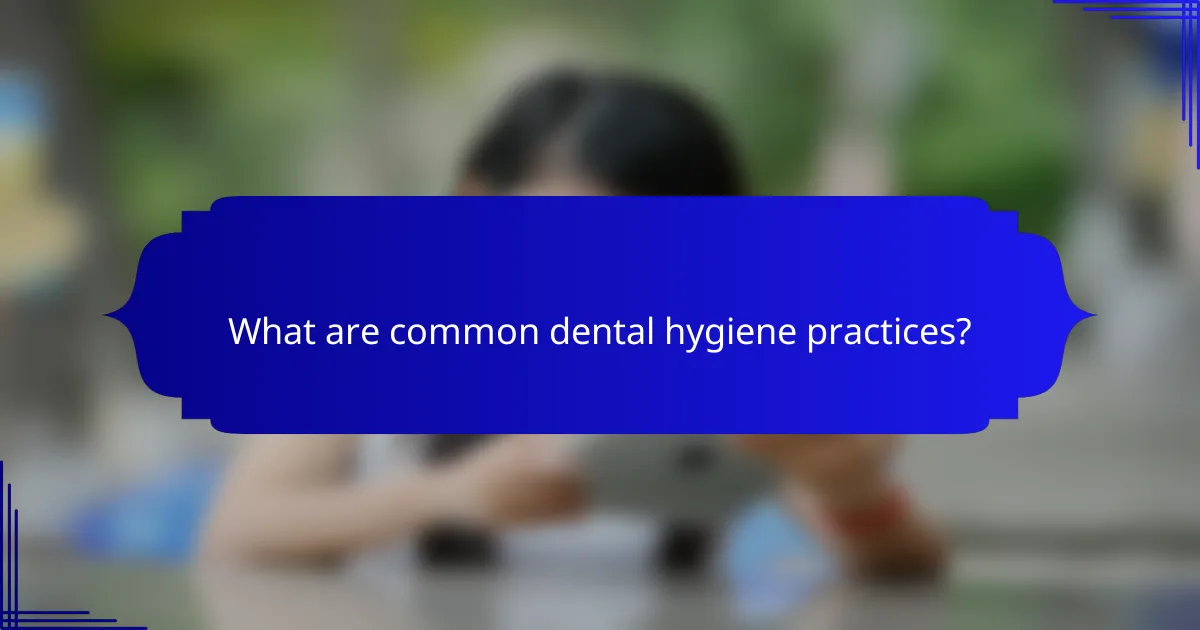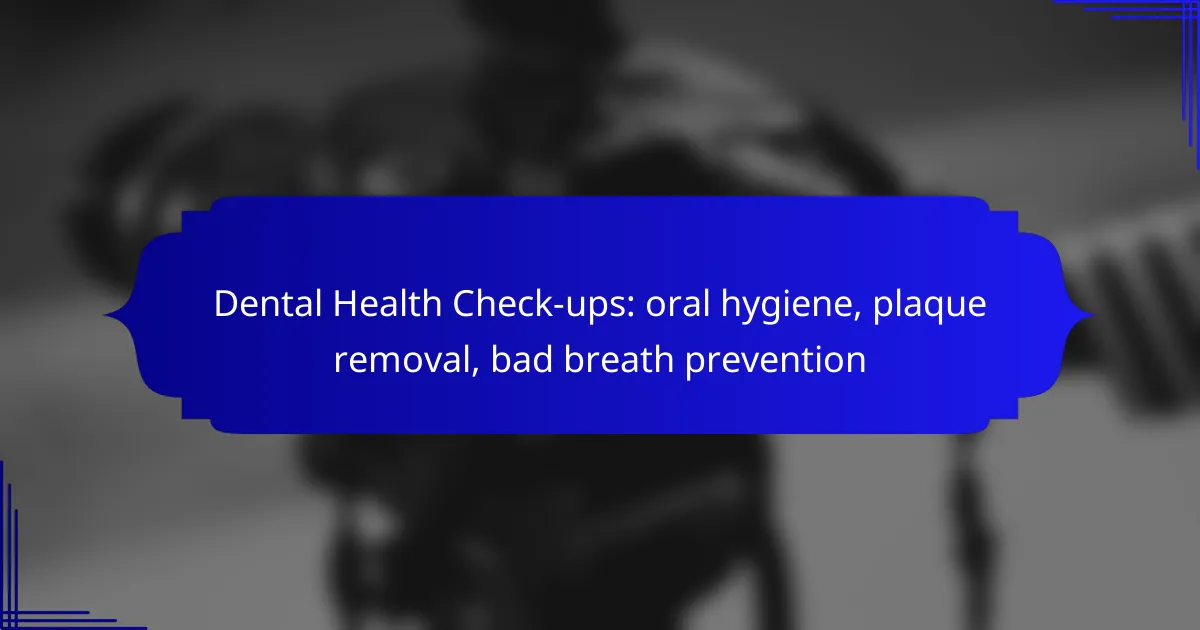Regular dental check-ups are crucial for maintaining optimal oral health, as they facilitate professional plaque removal and help prevent issues like cavities and gum disease. By visiting the dentist every six months, you can also address the root causes of bad breath, ensuring fresh breath and overall dental hygiene. Prioritizing these visits not only supports your smile but also contributes to your long-term well-being.

How often should you schedule dental check-ups in Australia?
In Australia, it is generally recommended to schedule dental check-ups every six months. Regular visits help maintain oral health, prevent plaque buildup, and address any issues like bad breath early on.
Every six months
Scheduling dental check-ups every six months is a standard practice for most individuals. These biannual visits allow dentists to perform thorough cleanings, check for cavities, and monitor gum health. Regular appointments can help catch problems before they escalate, ensuring better long-term dental health.
During these visits, dental professionals typically remove plaque and tartar, which can lead to gum disease and bad breath if left untreated. Consistent check-ups also provide an opportunity for personalized advice on oral hygiene practices tailored to your specific needs.
Annual check-ups for specific conditions
For individuals with specific dental conditions, such as gum disease or a history of cavities, annual check-ups may be more appropriate. These patients may require closer monitoring and more frequent cleanings to manage their oral health effectively.
In such cases, dentists may recommend tailored treatment plans that include additional visits throughout the year. This proactive approach can help prevent complications and maintain optimal oral hygiene, reducing the risk of bad breath and other dental issues.

What are the benefits of regular dental check-ups?
Regular dental check-ups provide essential benefits for maintaining oral health, including the early identification of dental issues and professional plaque removal. These visits help prevent complications such as cavities and gum disease, ensuring long-term dental hygiene and fresh breath.
Early detection of dental issues
Regular dental check-ups enable dentists to identify potential problems before they escalate. Conditions like cavities, gum disease, and oral cancer can be detected early, allowing for timely intervention and treatment.
During these visits, dentists perform thorough examinations, often using X-rays to uncover hidden issues. Catching problems early can save patients from more extensive treatments and higher costs down the line.
Professional plaque removal
Professional plaque removal is a crucial aspect of dental check-ups, as it helps prevent tooth decay and gum disease. Dentists and hygienists use specialized tools to remove tartar and plaque that regular brushing and flossing may miss.
It is recommended to have plaque removed at least twice a year, although some individuals may require more frequent cleanings based on their oral health. This process not only improves oral hygiene but also contributes to fresher breath and a brighter smile.

How can dental check-ups prevent bad breath?
Dental check-ups are essential for preventing bad breath by identifying and addressing the root causes of oral odor. Regular visits to the dentist help ensure proper oral hygiene, plaque removal, and the elimination of bacteria that contribute to unpleasant breath.
Identification of underlying causes
During a dental check-up, dentists can identify various underlying causes of bad breath, such as gum disease, tooth decay, or dry mouth. These conditions can lead to the accumulation of bacteria, which produce foul-smelling compounds.
Understanding the specific cause of bad breath allows for targeted treatment. For instance, if gum disease is detected, the dentist may recommend a deep cleaning or other interventions to restore gum health.
Teeth cleaning to eliminate odor-causing bacteria
Professional teeth cleaning is a crucial component of dental check-ups that helps eliminate odor-causing bacteria. Dentists use specialized tools to remove plaque and tartar buildup, which can harbor bacteria responsible for bad breath.
Regular cleanings, typically recommended every six months, can significantly reduce the number of bacteria in the mouth. This proactive approach not only freshens breath but also promotes overall oral health.

What is the process of a dental check-up?
A dental check-up typically involves a thorough examination of your oral health, including teeth, gums, and overall hygiene. This process ensures that any issues, such as plaque buildup or early signs of gum disease, are identified and addressed promptly.
Initial examination and consultation
The initial examination begins with a discussion between you and the dentist about your dental history and any concerns you may have. The dentist will then visually inspect your teeth and gums, checking for signs of decay, gum disease, or other oral health issues.
During this consultation, the dentist may use diagnostic tools, such as X-rays, to get a clearer picture of your dental health. This step is crucial for developing a personalized treatment plan and addressing any potential problems before they escalate.
Teeth cleaning and polishing
Teeth cleaning is an essential part of a dental check-up, where a dental hygienist removes plaque and tartar buildup using specialized tools. This process helps prevent cavities and gum disease, ensuring your oral hygiene is maintained.
After the cleaning, your teeth will be polished to remove surface stains and provide a smooth finish. This polishing can enhance the appearance of your teeth and leave your mouth feeling fresh. Regular cleanings, typically recommended every six months, are vital for long-term dental health.

What should you expect during a dental hygiene appointment?
During a dental hygiene appointment, you can expect a thorough cleaning of your teeth, an examination for any dental issues, and advice on maintaining good oral hygiene. This visit typically includes plaque removal and strategies to prevent bad breath.
Oral examination for cavities and gum disease
The oral examination focuses on identifying cavities and signs of gum disease. Your dentist or hygienist will visually inspect your teeth and gums, often using tools to check for any decay or inflammation.
If necessary, X-rays may be taken to reveal issues not visible to the naked eye, such as cavities between teeth or bone loss due to gum disease. Early detection is crucial for effective treatment and maintaining overall dental health.
Discussion of oral hygiene practices
Following the examination, your dental professional will discuss your oral hygiene practices. This includes reviewing your brushing and flossing techniques to ensure you are effectively removing plaque and preventing bad breath.
They may recommend specific products, such as fluoride toothpaste or mouthwash, and provide tips on how often to brush and floss. Adopting a consistent routine can significantly enhance your oral health and reduce the risk of dental issues.

How to choose the right dentist in Australia?
Choosing the right dentist in Australia involves considering their qualifications, experience, and patient feedback. A good dentist will not only provide quality care but also make you feel comfortable during your visits.
Check qualifications and experience
Start by verifying the dentist’s qualifications, including their education and any specializations. In Australia, dentists must be registered with the Dental Board of Australia, which ensures they meet national standards.
Experience is also crucial; look for a dentist who has been practicing for several years and has experience in the specific treatments you may need. For example, if you require orthodontic work, find a dentist who specializes in that area.
Read patient reviews and testimonials
Patient reviews and testimonials can provide valuable insights into a dentist’s practice. Check online platforms like Google Reviews or health-specific sites to gauge patient satisfaction and common experiences.
Look for consistent themes in reviews, such as the dentist’s communication skills, the friendliness of the staff, and the overall atmosphere of the clinic. Positive feedback in these areas can indicate a supportive and caring environment for your dental health needs.

What are common dental hygiene practices?
Common dental hygiene practices include regular brushing and flossing, which are essential for maintaining oral health. These practices help remove plaque, prevent bad breath, and reduce the risk of cavities and gum disease.
Brushing twice a day
Brushing your teeth twice a day is crucial for effective dental hygiene. Use a fluoride toothpaste and a soft-bristled toothbrush to gently clean all surfaces of your teeth for at least two minutes each time.
Make sure to replace your toothbrush every three to four months or sooner if the bristles are frayed. This ensures that you are using an effective tool for plaque removal and maintaining fresh breath.
Flossing daily
Daily flossing is an important practice that helps remove food particles and plaque from between your teeth where a toothbrush cannot reach. Aim to floss at least once a day, preferably before bedtime, to keep your gums healthy.
When flossing, use about 18 inches of dental floss, winding most of it around your middle fingers, and gently slide it between your teeth in a C-shape. Avoid snapping the floss, as this can damage your gums.

What are the signs you need a dental check-up?
Signs that indicate a need for a dental check-up include persistent bad breath, visible plaque buildup, and bleeding gums. If you experience any discomfort or changes in your oral health, it’s essential to consult a dentist promptly.
Oral hygiene
Maintaining good oral hygiene is crucial for preventing dental issues. Signs that your oral hygiene may be lacking include a coated tongue, frequent cavities, and gum inflammation. Regular brushing and flossing, along with routine dental visits, can help keep your mouth healthy.
To improve your oral hygiene, aim to brush your teeth at least twice a day and floss daily. Consider using an antibacterial mouthwash to reduce plaque and bacteria. If you notice any persistent issues, such as sensitivity or pain, consult your dentist for tailored advice.
Plaque removal
Plaque is a sticky film of bacteria that forms on your teeth and can lead to cavities and gum disease if not removed. Regular dental cleanings are essential for effective plaque removal, as brushing alone may not eliminate all buildup. Look for signs of plaque, such as a fuzzy feeling on your teeth or discoloration.
To minimize plaque accumulation, use a fluoride toothpaste and a soft-bristled toothbrush. Additionally, consider incorporating tools like interdental brushes or water flossers for thorough cleaning. If plaque buildup persists, it may be time for a professional cleaning.
Bad breath prevention
Bad breath, or halitosis, can be a sign of underlying dental issues or poor oral hygiene. To prevent bad breath, maintain a consistent oral care routine, including brushing your tongue and staying hydrated. If bad breath continues despite good hygiene, it may indicate a need for a dental check-up.
In addition to regular brushing and flossing, consider chewing sugar-free gum or mints to stimulate saliva production, which helps neutralize odors. Avoid foods known to cause bad breath, such as garlic and onions, especially before social events. If the problem persists, consult your dentist for further evaluation and treatment options.
